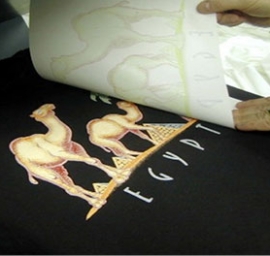After FX - Post Press Special Effects
The job is setup, the ink is set into the screens and the shirts are printed and loaded on the dryer belt. Finished, right? Not necessarily! There are many options to enrich printed designs and these post-production enhancements can be an effective way to create a texture, improve hand and add excitement to an otherwise bland print (or even to cover a mistake).
Foil Me Once…
The most widely-used after print effect is foiling. There are two methods used to apply foil to an already printed garment—applying foil with a transfer press after the print has been completed, and hand applying foil at the end of the oven/dryer.
Applying foil with a transfer press is the more commonly used approach. This application is usually simple and for one color. However, a multi-color can be enhanced using this technique if the non-foil colors are either mixed with foil resist, or printed thin with a water-base texture. The foils should be printed with a good deposit of plastisol type ink, preferably tinted toward the color of the final foil color.
The second most commonly used post-print application is hand applying foil at the end of the oven/dryer. Since this application can be inconsistent, it is most effective on fashion-oriented designs and fabrics. It also works for both single- and multi-color foil effects. The most successful way to achieve this type of effect involves five steps:
- Print the design with conventional inks (no matter if it is a single- or multi-color job).
- Flash cure the print.
- Print clear gel on top of the areas to be foiled. You may choose to pigment the gel to match the foil color.
- Print the gel through a 200 micron stencil to ensure a good layer of ink. It is imperative to print this gel on top of a flashed color; this will make it easier to print.
- Once the garment exits the dryer, lay the foil on the shirt and burnish with an eraser, squeegee or rolled up T-shirt. The harder the foil is rubbed on the shirt, the more foil will adhere.
When using this post-print application, it is best to design the print as a distressed style, so the foil can still look good even though it can be hit-or-miss.
This same print parameter can be used to create a very distressed look with a minor tweak—the person applying the foil at the end of the dryer just pats the gel area with a foil instead of burnishing it. A two-tone foil effect can also be achieved by running the garment through the oven and applying a different color of foil to the re-melted gel.
Tap Creativity
Plastisol ink is thermoplastic, an attribute which allows the cured surface of the ink to be heated to the point to which it can be manipulated. The most common post-surface manipulation is called “tapping”—the practice of placing a Teflon sheet over a cured print and hitting it with a transfer machine. Generally, a setting of 375°F (1900°C) at 40 pounds of pressure for 8-10 seconds is enough to change the surface area.
The sheet usually has a high gloss side and a satin side, and whichever side is used will impress a similar surface on the ink. Using the gloss side is a great way to make a print look like an old-time transfer, while the satin side of the Teflon sheet is more widely-used as it gives the ink a smoother, softer hand. This technique is commonly used overseas to achieve the smooth surface many brands call for.
To achieve different textures and finishes, a number of materials can be used in place of Teflon to yield great results. Textured papers supplied by transfer paper companies can create some interesting finishes, including everything from geometric designs and lines to reptile-skin patterns. By using these in conjunction with matching print patterns, designs are given an extra punch, taking them to the next level.
Normal transfer papers can also be used to create various surface effects. Cold peel (coated) paper will create a gloss finish, while hot split (uncoated) paper will create a smooth matte finish. Using Teflon and transfer paper in the tapping technique is also a great way to correct misprints or rough “orange peel” surfaces that sometimes happen on press.
In order to achieve random effects on the transfer press, aluminum foil can be used in the tapping technique. Wrinkle it and spread it back out to create a shattered look on gloss inks or a crushed velvet look on suede or puff surfaces. Pinch the aluminum foil randomly every three inches then spread it out; the effect on the garment will be more of a leather look. Using the dull side of the foil creates an unfinished leather look while the gloss side of the foil will create more of a finished leather surface. The best thing about this technique, other than the visual effects, is that the same foil can be used for multiple designs.
Another post-print tapping technique utilizes materials such as canvas, lace or mesh. All of these materials will leave their reverse impressions on the surface. This is a great way to create a faux appliqué effect or to achieve the look of a fabric surface.
There are many materials that can be used to manipulate the surface of cured plastisol ink. Once the procedure is set, the outcome is very consistent. The best way to discover these techniques is to practice them with misprints or seconds in the shop. After FX can be a great way to dress up an old design or, maybe just as important, to save a job.

